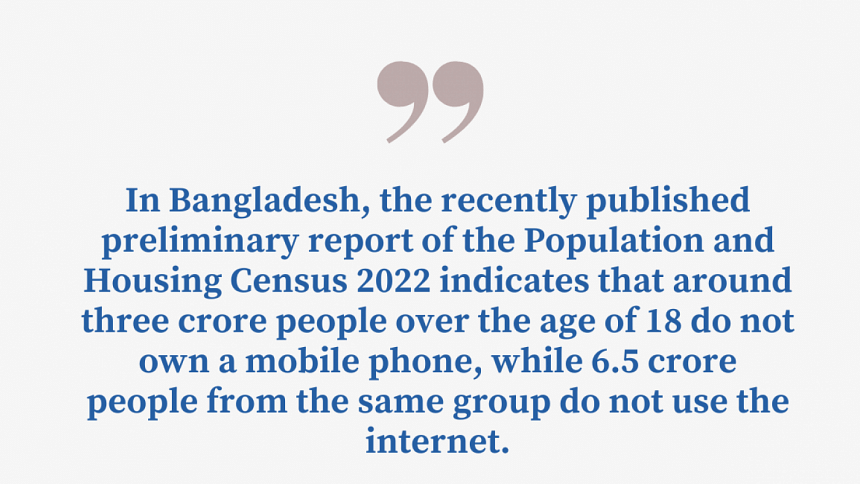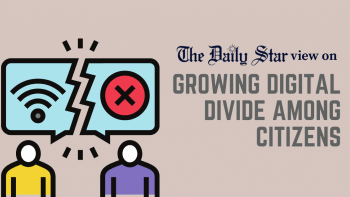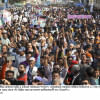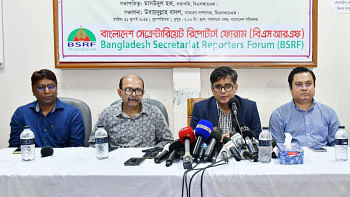Digital divide gets wider if there is power failure and servers go down frequently

How many of you have gone to the bank to get a statement of your account, and the bank teller informs you that the server is down? Or, went to the NRB Commercial Bank branch to pay your road tax only to be told to come back another day since the server is not working?
In this age of digitalisation, there are many advantages of this transition to the brave new world but it also comes with a few thorns. If there is load shedding in your area, or you have a bad internet connection, the challenges of carrying out simple transactions sometimes become a burden.
In Bangladesh, the recently published preliminary report of the Population and Housing Census 2022 indicates that around three crore people over the age of 18 do not own a mobile phone, while 6.5 crore people from the same group do not use the internet. As a result, it is easy to see that all people are not fully benefiting from the push toward "Digital Bangladesh". According to an editorial in The Daily Star (July 31, 2022), the frequency of lack of server access, poor user-friendliness of the apps and system, and slow internet speeds have created headaches for those who are seeking to use the 761 digitalised government services that are nominally available.
A research survey conducted to gauge the impact of Union Digital Center (UDC) in Companiganj Upazila of Sylhet found that the availability of electricity is a big problem in the upazila. The households can't use their computer or mobile when they need to use them because of load shedding. To quote, the "research survey also found the internet speed problem. They are still using mobile networks. Some people were satisfied with the mobile network, but some said their internet services are not good. There aren't high-speed connections in the study area like broadband connections. Some people complain that they face long internet loading times when they need to receive the services. It makes them bored. And internet costs are high."

Here I must mention though that some of the issues that we find in the rural areas of Sylhet can also raise its head in the USA. Server down, poor network speed, and denial of service (DOS) are still a headache in many urban areas of developed countries, not to speak of in remote regions. Add to that the perennial problem of the "digital divide" where only the privileged can have broadband access or a 5G network. On top of that, we all know about how network failures or system downtimes due to performance issues can make life difficult for those who have to rely on 24/7 service: air traffic control, transportation, healthcare, or banking.
Let us take another extreme but a real-life situation. Imagine a scenario where all transactions are done using digital currency. In this world, you don't need to carry any cash to buy goods nor can you use cash to purchase your everyday needs. In fact, today you can use Bkash, Venmo or many other varieties of digital payment methods/apps to buy and sell. And then one day, when you go to the store to buy your daily groceries, you realise that the checkout counter only accepts cash. There is a big sign which insists, "Cash only, no credit cards accepted." And readers, believe me, this is what I have occasionally faced at my local grocery stores!
In Bangladesh, the trend toward digitalisation has provided a pathway to deliver useful government information and various government services to users by using the internet and mobile technologies and enabled us to overcome weak physical infrastructure barriers and to increase accountability throughout the system. However, I have also heard that in many government offices, the online system is frequently out of order, and "the server is down" has become a much-dreaded sign. Clients who want to pay their electric bills or road taxes are turned away due to power outages, no connectivity, or other technical issues. What does that mean? The impact can be profound or temporary. However, these failures also provide the unscrupulous middleman or corrupt officials an opportunity to make a quick buck. I have written frequently about this issue and everyone is familiar with the increased "cost of transaction". A birth certificate, road license, NID, or other documents become a major expense for those who do not have the skills, training, or street smarts to beat the "digital" system.
So, what is the solution? There are very well-known and time-tested principles that need to be built in to create a computer system that is dependable, and stays operational even during power failures. Similarly, system designers need to prioritise dependability and use metrics to track both the availability and reliability of service.
Fault-tolerant systems use backup components that automatically take the place of failed components, ensuring no loss of service. These include:
a) Hardware systems that are backed up by identical or equivalent systems. For example, a server can be made fault tolerant by using an identical server running in parallel, with all operations mirrored to the backup server.
b) Software systems that are backed up by other software instances. For example, a database with customer information can be continuously replicated to another machine. If the primary database goes down, operations can be automatically redirected to the second database.
c) Power sources that are made fault tolerant using alternative sources. For example, many organisations have power generators that can take over in case mainline electricity fails.
In a similar fashion, any system or component which is a single point of failure can be made fault tolerant using redundancy.
Some important considerations when creating fault tolerant and high availability systems in an organisational setting include zero downtime, i.e., a highly available system has a minimal allowed level of service interruption. For example, a system with "five nines" (i.e., 99.999) availability is down for approximately 5 minutes per year. A fault-tolerant system is expected to work continuously with no acceptable service interruption.
The appropriate solution to create a fault tolerant system often requires careful planning, understanding of how elements fail and the impact of surrounding elements of the failure. Redundancy or a set of alternative means can ensure that there are no catastrophic failures.
A very interesting analogy is the case of a failure in an aircraft and an automobile. In the case of an airborne aircraft, there is no room for a failure that brings down the aircraft. On the other hand, in the case of a car which has a flat tire, the car's operating system can be designed to limp along until the tire can be replaced.
Dr Abdullah Shibli is an economist and works for Change Healthcare, Inc., an information technology company. He also serves as senior research fellow at the US-based International Sustainable Development Institute (ISDI).

 For all latest news, follow The Daily Star's Google News channel.
For all latest news, follow The Daily Star's Google News channel. 









Comments